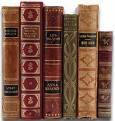                                        |
|
SHERWOOD ANDERSON
(1876-1941) |

 |
BACKGROUND
- born in Camden, Ohio
- Mother:
- Emma Jane Smith
- self-sacrificing
- Father:
- Irwin McClain Anderson
- Civil War vet (Union)
- harness repair & barn painter
- good storyteller
- influence on young writer
- later, drank too much & worked too little
- middle of 7 children
- moved frequently (to find work)
- attended school infrequently
- night school in Chicago
- Wittenberg College
- odd jobs:
- farm hand
- house painter
- factory worker
- newsboy
- copy editor
- later, owned his own paint business, farm
- veteran of Spanish-American War (1898-99)
- Genres:
- poetry
- fiction
- autobiography
- drama
- essay
|
BACKGROUND
- marriage & family:
- (1) 1904 – married Cornelia Lane
- her wealthy family
- 3 children
- his nervous breakdown
(1912)
- his move to Chicago
- their divorce
- (2) 1916 – married Tennessee Mitchell
- (who was involved w/CR’s ELM)
- (3) 1923 – married Elizabeth Prall
- (4) 1940 – married Eleanor Copenhaver
- 1916:
- Windy McPherson's Son
- 1st novel
- he = 40
- 1920s:
- friendship w/William Faulkner
- mentoring, sharing apartment in New Orleans
- Novels:
- Marching Men (1917), Mid-American Chants (1918),
Winesburg, Ohio (1919), Poor White (1920), short stories The
Triumph of the Egg: A Book of Impressions from American Life
(1921), Many Marriages (1923), short stories Horses and Men
(1923), autobiography A Story Teller's Tale (1924), In Dark
Laughter (1925), Tar: A Midwestern Childhood (1926),
Sherwood Anderson's Notebook (1926), editorials and sketches
Hello Towns! (1929), Beyond Desire (1932), Death in the
Woods (1933)
- Death:
- 3/8/1941
- peritonitis
- toothpick in martini olive before left on trip
- in Panama
- unofficial goodwill tour
- canal zone
- buried in Virginia
|
 |

 |
THEMES
- see Winesburg, Ohio
- see Chicago Renaissance
- loneliness, isolation, seclusion
- love, romance
- marginalization, poverty
- lack of fulfillment
- sexual repression
- thwarted lives
- disillusionment
- loss of traditional values in pursuit of American Dream
|
THEMES
- bemoaning the loss of traditional country
values
- wisdom
- hard work
- agrarian – in touch w/Nature
- independence
- lamenting the increase of materialistic &
industrial society
- criticizing the American Dream & the
Protestant Work Ethic
- that hard work would bring prosperity & reward
- American Dream =
- materialism
- industrialization
- disconnect from nature
- disillusionment
|
 |

 |
STYLE
- early influences = Gertrude Stein, Carl Sandburg
- voice of small-town America
- simplistic
story-telling style
- with complex
issues/themes
- language:
- simple, everyday, ordinary people
- the American Dream (struggles – see Chicago Renaissance)
- realism
- modernism:
- multiple perspectives
- psychology
- psychological realism
- characters illustrate psych. principles
- depth of characters
- inner workings
- conflict: man vs. society
- the unconscious
- introspective work
- (which adds to the realism)
- plotting:
- casual development
- complex motives
- psychological
- unlike the O. Henry model (carefully constructed) that
had dominated
- society =
- slice of life
- beauty of life, country (tragedy = what we do to Nature
& each other)
|
STYLE
- tone:
- folksy
- related to “plotting”
- narrator fumbles along
- downplays/minimizes/underestimates his intelligence
- notes his lack of education/sophistication – needs a
“Poet”
- awe at wonder & beauty of the Mid-West, Nature
- compassionate
- counters, softens nihilistic themes
- “Anderson's frank yet tender depiction of these thwarted
lives engages the imaginative participation of readers
through techniques Burton Rascoe has described as
‘selective, indefinite, and provocative, instead of
inclusive, precise, and explanatory.’” (http://www.enotes.com)
- grotesque
- spiritually unfulfilled, misshapened, crushed
individuals
- ** INFLUENCED
- style & themes
- Ernest Hemingway
- William Faulkner (see bio note)
- Chicago Renaissance:
- 1912-25
- Theodore Dreiser, Sherwood Anderson,
- Edgar Lee Masters, Carl Sandburg
- realistic depiction of contemporary city life
- influence of psychology
- bemoaning the loss of traditional country values
- wisdom
- hard work
- agrarian – in touch w/Nature
- independence
- lamenting the increase of materialistic &
industrial society
- criticizing the American Dream & the Protestant
Work Ethic
- that hard work would bring prosperity & reward
- disillusionment
- heavily influenced by journalism
- many had worked in newspapers
|
 |
LINKS
 LINKS
LINKS |















































































